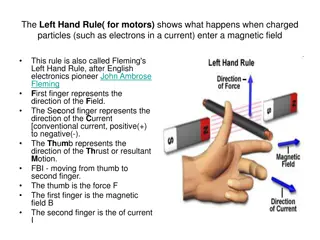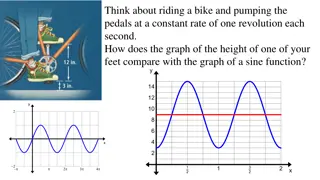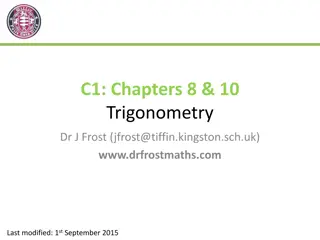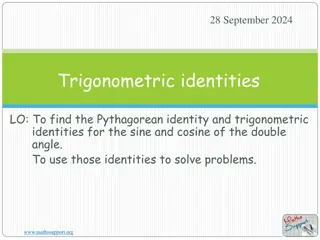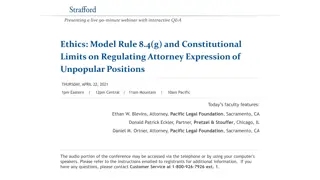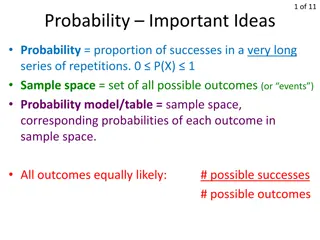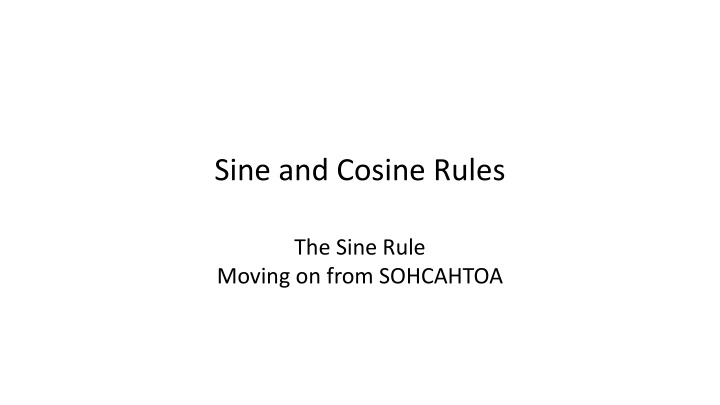
Understanding Sine and Cosine Rules in Trigonometry
Explore the Sine and Cosine Rules, essential in solving non-right triangles in trigonometry. Learn how to apply these rules using examples and understand their significance in finding side lengths and internal angles of various triangles.
Download Presentation

Please find below an Image/Link to download the presentation.
The content on the website is provided AS IS for your information and personal use only. It may not be sold, licensed, or shared on other websites without obtaining consent from the author. If you encounter any issues during the download, it is possible that the publisher has removed the file from their server.
You are allowed to download the files provided on this website for personal or commercial use, subject to the condition that they are used lawfully. All files are the property of their respective owners.
The content on the website is provided AS IS for your information and personal use only. It may not be sold, licensed, or shared on other websites without obtaining consent from the author.
E N D
Presentation Transcript
Sine and Cosine Rules The Sine Rule Moving on from SOHCAHTOA
Sine and Cosine Rules Previously we introduced Trigonometry and focused on right angles triangles, to bring in Pythagoras Theorem and some basic Trig Identities . Pythagoras Theorem works only for triangles with one right angle , but of course there are other sorts of triangles such as equilateral, scalene and isosceles that don t have any internal 90o angles so what about these? It s not a case of SOH CAH TOA here, there is a rule for finding side lengths and internal angles, in fact two rules known respectively as the SINE rule and the COSINE rule, effectively extensions of the Pythagoras Theorem.
Sine and Cosine Rules Previously we introduced Trigonometry and focused on right angles triangles, to bring in Pythagoras Theorem and some basic Trig Identities .
Sine Rule Either of the two expressions below will work for the Sine Rule if (as the rule states) we have 2 sides and an opposing angle, OR any 1 side and all 3 angles.
Sine Rule - Example 1 Using the sine rule again, we can establish that the length of the remaining side C is thus:
Sine Rule - Example 2 In the triangle shown, side AB = 12cm, angle B = 70o and angle C = 60o Using this information, calculate the value of angle A and the lengths of the remaining sides AC and BC C First of all, let us name the variables according to the Sine Rule convention: 12cm B Side C = 12cm Side B = ? cm Side A = ? cm Angle a = ? Angle b = 70o Angle c = 60o 70o 60o A From this data we can see that the problem is an ideal candidate for the Sine Rule
Sine Rule - Example 2 C = 12cm B = ? cm A = ? cm a = ? b = 70o c = 60o The given data has been summarised, now we can start C 12cm B 70o 60o A
Sine Rule - Example 2 Angle a is easily established from the fact that the internal angles of a triangle add up to 180o. Angle a is therefore 180 - (70 + 60) = 50o. Now ... two runs of the Sine Rule to calculate the lengths of sides A and B C 12cm B 70o 60o A
Sine Rule - Example 2 Angle a is easily established from the fact that the internal angles of a triangle add up to 180o. Angle a is therefore 180 - (70 + 60) = 50o. Now ... two runs of the Sine Rule to calculate the lengths of sides A and B C 12cm B 70o 60o A





